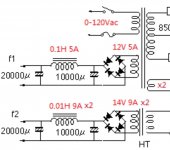For indirectly heated tubes it's ok, for DHTs it's no good.Even in DHT tubes. Is this CC filament supply type a good performer?
Constant Current? This is not a constant current supply. It's a passive DC voltage supply, and it is not constant either! The voltage will ride up and down with the mains voltage (as much as ±10%, not good for tube lifetime)Is this CC filament supply type a good performer?
And with AC 100% variable voltage, the lifetime tube will be less than with +- 10% variable voltage ?Constant Current? This is not a constant current supply. It's a passive DC voltage supply, and it is not constant either! The voltage will ride up and down with the mains voltage (as much as ±10%, not good for tube lifetime)
The RMS value of the unregulated dc supply will follow the RMS value of mains supply. ±10% mains RMS -> ±10% unregulated dc supply.
Aren't most indirectly heated tubes rated for +/- 10% heater voltage and filament tubes rated +/- 5%?
> Aren't most indirectly heated tubes rated for +/- 10% heater voltage and filament tubes rated +/- 5%?
Yes, 5% in some cases, 10% in others. But such a wide range simply reflects the reality of mains supplies: the valves were being sold for use in mains-operated consumer equipment.
It does not mean that the lifetime is the same, anywhere from -10% to +10%.
This snippet from the Philips Technical review [1956 ed.] gives some guidance, and shows the benefit of never going above the nominal voltage.

Yes, 5% in some cases, 10% in others. But such a wide range simply reflects the reality of mains supplies: the valves were being sold for use in mains-operated consumer equipment.
It does not mean that the lifetime is the same, anywhere from -10% to +10%.
This snippet from the Philips Technical review [1956 ed.] gives some guidance, and shows the benefit of never going above the nominal voltage.
- Home
- Amplifiers
- Tubes / Valves
- CC Filament Power supply performance.
